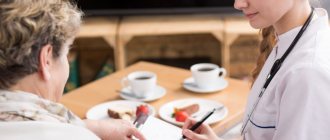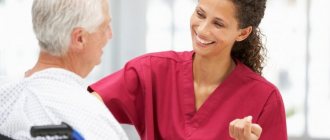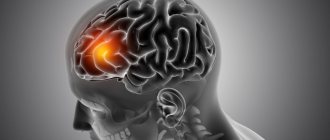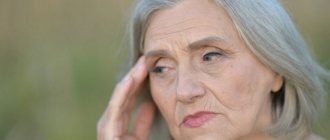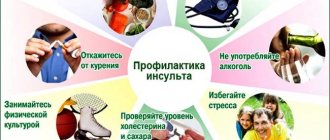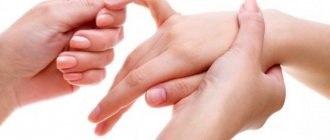Cognitive processes
There are three types of cognitive impairment after a stroke:
- Damage to one of the cognitive functions: memory (amnesia), the ability to perform any actions (apraxia), impairment of visual, auditory, tactile perception (agnosia).
- Violation of several functions that generally do not affect social adaptation.
- Multiple injuries that lead to social maladaptation: impaired attention, memory, volitional processes. In this case, post-stroke dementia is diagnosed. In older people with dementia, household activity decreases and self-care skills are lost. This category of patients is at risk of recurrent stroke.
The first and second variants of the disorder can be corrected due to the plasticity of the brain: damaged functions are compensated by functions that remain intact.
Rehabilitation of older people with post-stroke dementia includes sessions with psychologists. With the help of special exercises, patients develop auditory and visual memory, the ability to concentrate, and solve logical problems. The recovery process is accompanied by drug therapy.
Content
What is a stroke?
Complications after a stroke
- Paralysis
- Coma
- Brain swelling
- Aphasia
- Loss of coordination
- Apraxia of walking
- Relapse of the disease - why does it happen?
Who can have a stroke? Predisposing factors
- The main distinguishing features of female attacks
- In men
Precursors of stroke
The main thing is to see a doctor in time
Drugs for stroke
What is a stroke?
The disease is an acute circulatory disorder in the human brain. The attack develops rapidly. It takes from a few minutes to several hours for a person to be seriously injured - sometimes irreversibly. Doctors call the limit of providing effective assistance a time period of 6 hours. After this, the patient will no longer be able to recover if he survives. The consequences of a stroke are the death of brain cells due to oxygen starvation.
The two most common types of stroke are:
- By ischemic type (ischemic) – occupies a share of 75%. The peculiarity of this pathology is blockage of blood vessels or their compression. Damage occurs as a result of the presence of embolism, thrombosis and some other pathologies of the blood, blood vessels, and heart. Mortality rate is up to 15%.
- By hemorrhagic type (hemorrhagic) - occurs in 20-25% of cases. In this type of stroke, blood vessels rupture and bleeding occurs in the brain. Mortality rate – up to 35%.
Very rarely (up to 7% of cases) subarachnoid hemorrhage occurs. Its causes are traumatic brain injury or rupture of an arterial aneurysm (also due to trauma to the patient). In this case, the hemorrhage is directed into the space between the soft and arachnoid membranes of the brain. As a result of such a “blow”, more than half of the victims die.
You can undergo an examination in our clinic at the address: St. Petersburg, st. Bolshaya Raznochinnaya, 27 metro station Chkalovskaya
Causes of stroke and provoking factors
There are a number of diseases and external factors that can trigger the development of a stroke. These include:
- bleeding disorders, hypertension, thrombosis and embolism;
- cerebral aneurysms;
- atherosclerosis, diabetes mellitus;
- carotid artery stenosis;
- unhealthy lifestyle (obesity, insomnia, irregular daily routine);
- alcohol abuse, smoking;
- depression, fatigue;
- apnea (stopping breathing);
- general hypothermia, injuries;
- hereditary predisposition;
- age over 50 years.
Complications after a stroke
Paralysis
This complication occurs when the motor center is involved in the pathological process. Most often, hemorrhage occurs in the left hemisphere of the brain, as a result of which the right side of the body is “taken away”. Paralysis can also be left-sided. As a result, the patient cannot contract muscles or make any movements. At the same time, behavior and perception of the surrounding world differ in patients with right- or left-sided paralysis. Often there is a mental disorder (excessive aggression, for example) or thinking.
Coma
This condition can last from several hours to several years. Coma occurs due to damage to the cortex and subcortical substance of the brain, as a result of which all signals are inhibited. In a coma, the patient's breathing and cardiac function are depressed, he is unconscious, and his reflexes are impaired. Some fall into a coma quickly, while others gradually. In the second case, within a few hours:
- the patient yawns frequently;
- general fatigue and malaise are felt;
- pulse changes;
- the body goes numb;
- coordination of movements is impaired;
- limbs lose sensitivity and mobility;
- there is a disturbance of consciousness;
- breathing activity becomes superficial.
Brain swelling
One of the most dangerous manifestations of a stroke. Symptoms include: convulsions coupled with psychomotor excitability, headache, nausea and vomiting against the background of increased intracranial pressure.
Edema is divided into two types:
- Cytotoxic. Brain cells swell due to a lack of oxygen and adenosine triphosphate. As a result, membrane pumps do not work properly, sodium ions penetrate into the cells, and water accumulates.
- Associated with impaired outflow of intercellular and interstitial fluids, as well as blood. Occurs when capillaries are damaged.
Aphasia
Impaired speech and writing ability. May include an inability to understand what others are saying, slow speech, and difficulty remembering and writing.
Loss of coordination
During a stroke, muscle tone and coordination of movements are impaired. As a result, a person cannot move without assistance. The muscles also spasm, as a result of which the patient’s actions are even more difficult, since he is forced to overcome the resistance of his own body.
Apraxia of walking
A person can take steps, but in general the process of walking cannot be controlled.
Relapse of the disease, why does it happen?
Provoking factors for the second and subsequent attacks are atherosclerosis, hypertension, thrombosis, abnormal vascular structure, and diabetes. In addition, patients often harm themselves. Having overcome the first difficulties, they neglect to visit the doctor and follow his recommendations. Many people return to bad habits and do not treat associated pathologies.
Possible consequences
A stroke can result in temporary disability, disability, or even death. Only 20% of people who have had this disease can fully return to work. Every year in Russia, stroke occurs in about 450,000 people. According to statistics of recorded deaths from stroke, this cause ranks second among all deaths in our country. The most common consequences of the disease include:
- impaired movement, weakness in the limbs, numbness of various parts of the body;
- memory, speech, and urination disorders;
- loss of ability to care for oneself independently.
Who can have a stroke? Predisposing factors
It is generally accepted that stroke occurs only in older people. However, in recent decades the disease has been rapidly becoming younger. An attack can occur as early as 40 years of age or even earlier.
Main risk factors:
- disturbances in sleep and nutrition when entering a “dangerous” age – over 50 years;
- hypertension;
- chronic heart disease;
- high stress loads at work;
- smoking and alcohol abuse;
- temporary, rapidly passing ischemic attacks;
- high blood cholesterol levels;
- obesity;
- diabetes mellitus (it increases the likelihood of not only the first, but also a second stroke);
- hereditary factor;
- lack of timely hospitalization during an attack and lack of qualified medical care in municipal hospitals;
- trauma (the rarest cause of stroke)
However, symptoms and causes differ between women and men.
The main distinguishing features of female attacks:
- the predominance of the disease is of the hemorrhagic type;
- very long and difficult recovery of functions;
- high mortality;
- high loads on blood vessels during pregnancy;
- Among the main causes are migraines, headaches, and great stress;
- it’s easier to see the first symptoms of an approaching “blow”;
- One of the provoking factors is taking oral contraceptives.
The most pronounced symptoms in women include: weakness, slowness of movement, shortness of breath, wheezing, increased heart rate, blurred vision, double vision, fainting, impaired hearing, pain on one side of the face and body, and unbearable headache.
In men
The main risk factors are impaired blood circulation, blockage of blood vessels, rupture of arteries with subsequent hemorrhage, blood thickening due to various diseases, obesity, diabetes mellitus, lack of physical activity, poor diet and eating disorders, bad habits, severe physical activity, vegetative-vascular dystonia, hypertension .
The main signs of a stroke in men may appear periodically, but go away over time. In this situation, the most dangerous thing is to decide that the trouble is over. After all, most likely, these are just transient ischemic attacks, signaling the approach of a stroke.
With the ischemic type, a man may feel dizziness, severe headache (it cannot be relieved by painkillers), weakness, decreased sensitivity in the limbs and numbness, short-term fainting, and vomiting.
A hemorrhagic attack is expressed by loss of consciousness, a sharp increase in pressure, the face becomes very red, noises are heard when breathing, facial asymmetry is noticeable, and vomiting occurs.
October 29 – World Stroke Day
Stroke is one of the leading causes of death and disability in the world. It is impossible to predict its occurrence, but reducing the risk is quite simple.
This day was first celebrated in 2004, when the World Health Organization declared stroke a global epidemic. This initiative by WHO and partners is dedicated to disseminating information about such a common and dangerous disease as stroke. This disease remains one of the main causes of death and disability both in the world and in Russia. Vascular diseases account for more than half of deaths, and about a fifth of them occur in people of working age.
In Russia, the mortality rate from stroke is one of the highest in the world, about 200,000 people die annually, and the same number remain disabled. According to the National Stroke Registry, 31 percent of people who survive the disease require assistance, 20 percent cannot walk independently, and only eight percent of survivors can return to their previous jobs.
Very often, neither the patients themselves nor the people around them even suspect that they are having a stroke. But the future life and health of a person depends on the correct and quick “recognition” of the disease and the provision of first aid.
In Russia, on the initiative of a group of relatives of patients and the National Association against Stroke (NABI), an interregional fund to help relatives of stroke patients, ORBI, was created in 2006. This public organization teaches relatives of patients the basics of care, provides them with information about treatment and rehabilitation centers, and conducts educational campaigns for the general population.
What is a stroke?
A stroke is a circulatory disorder in the brain caused by blockage or rupture of blood vessels. This is a condition when a blood clot - thrombus - or blood from a ruptured vessel interferes with blood flow to the brain. Lack of oxygen and glucose leads to the death of brain cells and impairment of motor functions, speech or memory.
What happens
Three quarters of all cases of the disease are ischemic stroke. This term refers to a condition in which a blood clot blocks a blood vessel and blocks blood flow to a certain part of the brain.
Typically, a blood clot forms somewhere in the peripheral vessels of the body, breaks off, and travels through the bloodstream to the brain. There it gets stuck in the small vessels of the brain and blocks the blood flow in them.
The second type of stroke – hemorrhagic – is much less common. It occurs when a blood vessel in the brain ruptures.
If the vessel is on the surface of the brain, the leaked blood fills the space between the brain and the skull. This is called subarachnoid bleeding. And if a vessel bursts in the deeper structures of the brain, blood from it fills the surrounding tissues.
But the result of both types of bleeding is the same - disruption of blood flow to nerve cells and pressure of accumulated blood on brain tissue.
Consequences of a stroke
Damage to a small area of the brain leads to minor impairments – weakness of the limbs. Impaired blood circulation in large areas of the brain causes paralysis and even death: the degree of damage depends not only on the scale, but also on the location of the stroke.
Many people who have had a stroke are left partially or completely paralyzed on one side of the body, and have difficulty speaking and controlling urination and bowel movements. Intellectual abilities - memory, cognitive functions - also suffer
Symptoms of a stroke
The onset of a stroke is usually asymptomatic. But after a few minutes, brain cells, deprived of nutrition, begin to die, and the consequences of the stroke become noticeable.
Common symptoms of a stroke:
- sudden weakness in the face, arm, or leg, most often on one side of the body;
- sudden confusion, problems speaking or understanding speech;
- sudden vision problems in one or both eyes;
- sudden disturbance in gait, dizziness, loss of balance or coordination;
- sudden severe headache of unknown cause.
It is very important to immediately recognize its symptoms in order to call an ambulance as quickly as possible. After all, the sooner treatment is started, the better a person recovers from a stroke.
Remember! The time it takes to restore blood flow in an artery after an ischemic stroke and stop the death of brain cells - the “therapeutic window” - is 6 hours. The sooner you seek medical help, the more effective the treatment will be.
Learn more about stroke symptoms.
How to recognize a stroke
If you think you are seeing symptoms of a stroke, take a simple three-item test. If it is difficult to complete all three tasks, immediately call an ambulance, immediately clarifying that it is a suspected stroke.
- Ask the person to smile widely , showing his teeth. During a stroke, the smile loses its naturalness, becomes very tense and looks like a grin, or one-sided and crooked.
- Then ask to close your eyes, raise your arms and hold them in this position for 10 seconds. During a stroke, the muscles weaken and it is difficult to keep them lifted for a long time. If one arm does not rise at all, this is also a sure sign of a stroke.
- Next, ask them to repeat a sentence, for example: “The weather is nice this morning.” A stroke is characterized by speech impairment, and the patient copes poorly with this task.
What causes a stroke?
- Blood clots that cause ischemic strokes usually form in arteries whose lumen is narrowed due to atherosclerotic plaques . These are deposits of proteins that transport cholesterol.
- Blood clots can form due to poor heart function or due to injury that ruptures blood vessels in the limbs, abdomen, or chest.
- Hemorrhages are also caused by increased blood pressure - it leads to rupture of small vessels in the brain.
- Another cause of stroke is the rupture of aneurysms, abnormally dilated areas of blood vessels. But this problem is often caused and aggravated by high blood pressure.
Main development factors
A stroke can affect anyone. Some risk factors, such as developing an aneurysm or developing a blood clot from injury, are difficult to control.
However, a significant number of factors are mainly due to lifestyle.
These factors include:
- high blood pressure;
- high cholesterol;
- diabetes;
- obesity and overweight;
- cardiovascular diseases;
- smoking;
- drug use;
- alcohol consumption.
In addition, stroke is more likely to develop in people over 55 years of age and those whose close relatives have already suffered from a stroke. In the age range from 45 to 55 years, stroke occurs twice as often in men as in women.
To understand whether there is a risk of stroke, complex studies are not needed. It is enough to monitor the condition of blood vessels and blood pressure, eat normally, and do not smoke.
You can get checked completely free of charge at the Health Centers.
How to prevent it?
Stroke prevention is based on the basic principles of a healthy lifestyle .
- Know and control your blood pressure.
- Don't start smoking or stop smoking as soon as possible.
- Add as little salt as possible to your food and avoid canned and processed foods that contain excess salt.
- Control your blood cholesterol levels.
- Follow the basic principles of a healthy diet - eat more vegetables and fruits, avoid added sugar and saturated animal fat.
- Don't drink alcohol. The risk of stroke is highest in the first hours after drinking alcohol.
- Exercise regularly. Even moderate physical activity - walking or cycling - reduces the risk of developing cardiovascular diseases, including stroke.
What are the signs of a stroke and what should be done?
What is a stroke?
The brain can only function if blood flows through it. Two large blood vessels located on either side of the neck carry blood from the heart to the brain. The blood vessels branch and become smaller and smaller until tiny blood vessels supply oxygen and nutrients to all parts of the brain. A stroke occurs in the same way as a heart attack, but occurs in the brain. If the blood supply to the brain is interrupted, the brain is deprived of its supply of oxygen and nutrients. This causes damage to brain tissue, which we call a stroke.
Strokes are caused primarily by an occlusion that prevents blood from flowing to the heart or brain. The most common cause of this is the development of fatty deposits on the inner walls of the blood vessels supplying the heart or brain. They narrow blood vessels and make them less flexible. This phenomenon is sometimes called arteriosclerosis or atherosclerosis. In this case, the likelihood of blocking blood vessels with blood clots increases. When this happens, the blood vessels are unable to supply blood to the heart and brain, which become damaged.
Strokes can also be caused by two other reasons:
- A blood vessel in the brain can rupture and cause bleeding, damaging brain tissue. This is called intracerebral hemorrhage. In this case, high blood pressure is an important risk factor. You can find out more about high blood pressure in Section 9.
- If a person has a weak or irregular heartbeat, blood clots can form in the heart and travel through the blood vessels to the brain.
These clots can become lodged in one of the brain's narrow arteries, blocking the flow of blood to the brain area.
Major stroke
The most common symptom of a stroke is sudden paleness in the face or weakness in an arm or leg, most of the time on one side of the body. Other symptoms include the sudden onset of:
- numbness of the face, arms or legs, especially on one side of the body;
- confusion, difficulty pronouncing words or understanding speech;
- difficulty looking with one or both eyes;
- difficulty walking, dizziness, loss of balance or coordination;
- severe headache of unknown cause;
- fainting or unconsciousness.
The effects of a stroke depend on what part of the brain is damaged and how severe the damage is. A stroke can affect only one part of the body, such as the face, arm, or leg. It can also completely paralyze one part of the body. A very severe form of stroke can cause sudden death.
Microstroke
A microstroke is also called a transient cerebrovascular accident. The signs of mini-strokes can be similar to those of major strokes, but they are milder and last only a short time, usually less than an hour. The person often recovers without any treatment. These mini-strokes are a warning; Most people who have had one or more mini-strokes may later suffer a major stroke.
Note: A person can have a major stroke without any previous mini-strokes.
What to do in case of a stroke
If you see signs of a stroke in someone, call a doctor or ambulance immediately, or take the person to the nearest hospital emergency room. Do this even if the symptoms are not very severe, since the stroke can progress. You should do the same in case of a mini-stroke. If there is no hospital or health center nearby, call your doctor immediately.
Stroke treatment
The level of medical care you receive may vary depending on where it happened. The amount of help you need depends on how severe your stroke is.
If you arrive at the hospital within three hours of the first sign of a stroke, your doctor may immediately give you an antithrombotic drug to dissolve blood clots in your arteries. However, the choice of treatment will depend on the exact cause of the stroke.
To diagnose the type of stroke you have, your doctor will review your medical history, do a physical exam, and do tests such as a computed tomography (CT) scan and magnetic resonance imaging (MRI).
These tests will show whether you have an ischemic disorder (caused by an occlusion) or an intracerebral hemorrhage (caused by a ruptured blood vessel in the brain).
Your doctor may prescribe medications to relieve your symptoms and prevent another stroke, and may recommend changes to your lifestyle to reduce your risk. If you follow these guidelines, you will achieve the best results. Listen carefully to your doctor's instructions and ask questions if necessary.
In some patients, special surgical procedures to remove cervical artery occlusions, such as carotid endarterectomy or stenting, may prevent recurrent strokes.
Rehabilitation and long-term care
Patients paralyzed after a stroke require special care in the hospital in order to recover and avoid complications and long-term disability. Many stroke patients remain disabled to one degree or another and require long-term care at home.
A significant part of stroke rehabilitation involves teaching patients how to exercise safely. It also includes:
- providing assistance with walking, eating, dressing, bathing, cooking, reading, writing and toileting;
- speech therapy;
- conducting checks to ensure that patients can live safely at home;
- assistance in organizing medical and rehabilitation care and drawing up schedules for its provision;
- counseling patients and their families, including recommendations regarding the conduct of financial, legal and commercial affairs;
- occupational therapy to help patients maintain physical activity and activity;
- physical therapy to help regain mobility.
Medicines used for the treatment and management of patients with strokes
Medicines often used to treat stroke include:
- antiplatelet agents such as aspirin;
- anticoagulants or blood thinners such as warfarin;
- medicines to control blood pressure, such as calcium channel blockers and angiotensin converting enzyme inhibitors;
- medicines to reduce blood fat.
These medications must be used under medical supervision.
Is it possible to recover after a stroke?
Yes, you can, but the extent of long-term disability depends on how long the brain damage caused by the stroke lasts. Many stroke survivors remain disabled due to mental and physical disabilities. They need support from family and friends to help them cope.
How can you avoid having another stroke?
It is important to maintain a healthy lifestyle and be sure to take medical treatment such as aspirin and blood pressure medicine. People who have had a stroke are more likely to have another stroke.
If you have an irregular heartbeat (atrial fibrillation), it is also important to take this into account and seek medical help to prevent another stroke. Consult your doctor regarding this matter.
Precursors of stroke
Symptoms before an attack appear within a few days. However, many do not pay attention to them, because the signs of an impending stroke disappear on their own.
How to recognize the proximity of a “blow”? The most important harbingers:
- headaches that appear suddenly and go away quickly;
- weakness unexpected for a person;
- causeless nausea;
- short-term dizziness;
- frequent mood changes.
You also need to pay attention to symptoms such as:
- visual and hearing impairments;
- slow pulse;
- numbness of the limb;
- flushes of blood to the face;
- disturbance of speech function or coordination of movements;
- severe sweating.
If you have these symptoms, you should immediately consult a doctor, as it is still possible to prevent a stroke.
Within 3 hours from the moment of formation of a brain lesion, acute manifestations of a close “impact” occur:
- difficulty swallowing;
- unbearable headache that leads to fainting;
- severe dizziness;
- vomit;
- convulsions;
- breathing problems;
- tachycardia.
At this stage, the victim requires urgent hospitalization. With timely provision of first aid, the likelihood of severe complications will be reduced.
The main thing is to see a doctor in time
The doctor who treats strokes is a neurologist. He takes part in the restoration of lost mental and physical functions. The main tasks of a specialist when working with patients who have already been discharged from the hospital are secondary prevention, which is aimed at preventing a recurrent attack, as well as drug treatment of the consequences of the “stroke”.
A modern method for diagnosing pathology is ultrasound duplex scanning of neck vessels. An image of the vessel is formed, its patency and structure are displayed. Diagnostics allows timely detection and prevention of vascular diseases, including stroke.
You need to undergo the study if:
- frequent fainting, headaches, dizziness;
- hypertension;
- arrhythmias;
- elevated cholesterol levels;
- traumatic brain injuries;
- sleep, vision and hearing disorders;
- weakened attention, memory loss.
The necessary studies are prescribed by a neurologist. Based on diagnostic data, treatment is prescribed, which varies depending on the type of stroke.
Our clinic address: St. Petersburg, st. Bolshaya Raznochinnaya, 27 metro station Chkalovskaya
